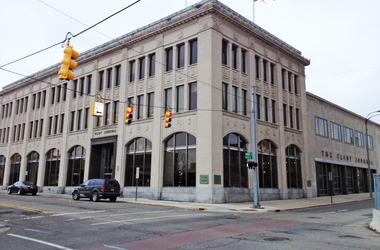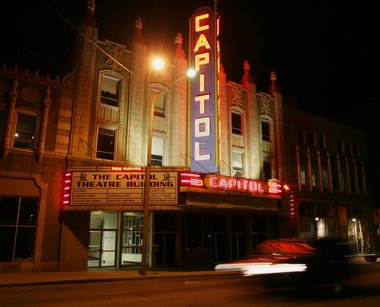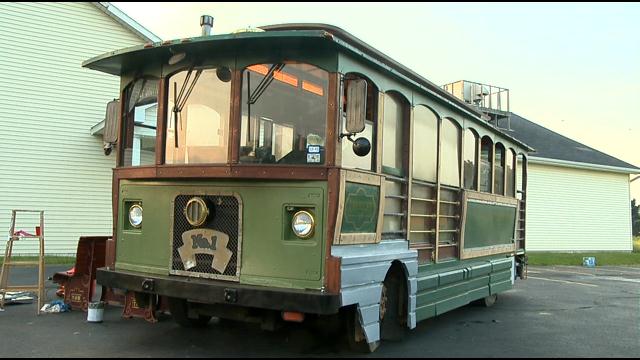FLINT, MI — News that 100 Michigan State University medical students are coming to downtown Flint is touted as an economic home run, bringing high-paying jobs, additional residents and education to the area.
“This is the next step forward in advancing the work to revitalize the economy,” said Betsy Aderholdt, the chief executive officer of Genesys Health System. “Two of the strongest assets the community has are the education and health care institutions. This creates that catalyst to advance that – ‘eds’ and ‘meds’ revitalizing that sector of the economy.”
The MSU Board of Trustees voted Friday, Jan. 25, to pursue a 20-year lease, paying an estimated $700,000 a year in rent to occupy 40,000 square feet of the former Flint Journal building, which is owned by Uptown Reinvestment Corp. The 40,000 square feet will be used for office and teaching space.
Uptown Reinvestment bought the building last year, paying $1.6 million, according to city records.
The purchase included the newspaper’s former printing facilities, which is near the main building, located at 200 E. First St.
MSU’s College of Human Medicine had announced plans in late 2011 to expand its medical education and public health programs in Flint with a $2.8 million grant from the Charles Stewart Mott Foundation.
Bringing MSU staff and students to the downtown will be very helpful to local businesses, said Kathy Jackson, owner of the Healthy Dollar.
“You are talking about bringing in a group of students who are already educated and working on advanced degrees and Flint has said it wants to be a university town and the health agencies are really building up here,” she said. “It’s just enhancing the quality of life.”
“Whenever you think about education and health care, that just enhances the whole image of an area,” Jackson said.
MSU officials said they are looking forward to setting up shop in Flint.
“We are delighted with today’s next step toward expanding our college’s program in public health and medical education in downtown Flint and feel that the former Flint Journal building is an ideal setting for learning and research,” said Dr. Marsha Rappley, dean of the MSU College of Human Medicine, in a written statement.
“MSU continues to work closely with the Charles Stewart Mott Foundation, Uptown Reinvestment Corporation and other partners on these plans and we look forward to working together to find solutions to important public health issues in Flint.”
The reuse of the building fits well with what the previous owners had hoped to see.
“When we sold the historic Journal building, we had high hopes that the building would become redeveloped,” said Marjory Raymer, MLive-Flint Journal community news director. “We are so glad to see that it will continue to be an asset for this community and be a part of the continued downtown revitalization efforts. Welcome to downtown, MSU.”
The school is a good fit with a downtown Flint clinic Genesys is opening on South Saginaw Street that will provide training for medical students, Aderholdt said.
“To have our training site very closely located with the medical students, it really creates a very strong model that demonstrates collaboration between MSU and the health care sector of our economy,” she said. “As they move their public school here and really get into the community, I think it’s really going to take the community’s game to the next level. This will be a world-class public research function located right here in downtown Flint.”
The expansion will help cultivate an already longstanding relationship that McLaren has with Michigan State University, said Dr. Jason White, vice president of Medical Affairs at McLaren-Flint.
“I think it’ll be great with the medical community,” White said. “We’ve had a great relationship with them for a number of years, bringing students in for their third and fourth years. This will bring a lot of students in as well as a lot of the faculty that will be teaching them. They’ll go to school here, live here and start families here, and that will add to the community.”
White said that the medical school will provide the area with “physician longevity,” so that there will always be a pool of local talent.
“If you bring in fifty 30-year-olds, in 30 years, you’ll have a bunch of 60-year-old physicians with no one to replace them,” he said. “This way, you’ll always have new physicians available from different age groups, and that provides for physician longevity.”
The implementation of a downtown school could have long-term positive effects on the medical workforce and on the community as a whole, said Jim Buterakos, academic officer Hurley Medical Center.
“I think it’s good for Flint and it’s important, because the increase in students and people in downtown Flint means success for the entire city,” Buterakos said. “It’s been a long time since MSU has been down here. Since 1972, I believe. This move definitely increases their visibility in the community.
Expanding the number of medical students in Flint could result in a larger number of medical professionals taking root in the Vehicle City, he said.
Going along with the 40,000 square feet in the former Journal building that MSU will use are plans for residential space in the structure.
The main Journal building is about 120,000 square feet. The space that MSU isn’t using will be 16 loft apartments positioned on the upper floors, said Tim Herman, president of Uptown Reinvestment and CEO of the Genesee Regional Chamber of Commerce.
The exact details of the lease are still being worked out, although the goal is for renovations to start the summer of 2013 and for MSU to move into the building the summer of 2014, Herman said.
Architects are developing renovations that can be performed without impacting the historic nature of the building, he said.
“It’s great news and it’s an important next step in the process of bringing MSU to downtown Flint,” he said. “It will complement the already thriving higher education community.”
The addition of MSU will continue to help stabilize the downtown and bring very high-paying jobs to the community, Herman said.
The former Journal building is part of a projected $30 million redevelopment plan that incorporates properties that include the Genesee Towers building.
Uptown Reinvestment Corp. bought Genesee Towers from the city of Flint with the intention of tearing the building down as part of the multimillion-dollar redevelopment proposal.
“This is just the next step and we want to keep any cash coming out of any of these deals in downtown so it goes into the next deal,” Herman said. “We are very, very happy to leverage all of the other developments in the downtown into what we are doing with this $30 million possible renovation that we are going to do with all the properties, including Genesee Towers.”
Development has already taken place north and south on Saginaw Street, so it will be nice to see it expand eastward, said Ryan Beuthin of The Flint Crepe Co., located downtown on Saginaw Street.
“It will be interesting to watch Flint expand in the east-west directions,” he said. “We’ve seen a lot of north-south focus — just seeing blocks outside of Saginaw Street develop and what the different dynamic will be.”
The medical school makes a lot of sense, and will have an immediate impact on the city’s downtown, said Gerard Burnash, the executive director of the Flint Downtown Development Authority.
“Clearly, the DDA welcomes the news that MSU has chosen the Flint Journal building. I think that’s a great repurpose for that property and it really promotes the development of downtown,” Burnash said.
“Contractors will be moving in there right away, and as soon as the students move in, there will be an improvement in residential real estate as well as lunch crowds for local restaurants and just an overall improvement to business for the downtown area.”
“Anything where we can get more bodies down here is a good thing,” Kittel said.
Elected leaders were pleased to know the deal bringing another university to the downtown was moving forward, citing it as a chance to improve the regional economy.
“The addition of MSU to Flint crystalizes our downtown as the premier location for higher education,” Flint Mayor Dayne Walling said. “There is nowhere else in the state where MSU and U of M are across the street from each other.” The building is on First Street, across the street from the University of Michigan-Flint campus.
MSU coming to Flint is phenomenal news for the region, Genesee County Board of Commissioners Chairman Jamie Curtis said, adding work is being done to diversify the county’s economy and the health care industry is continuing to grow.
“We need to bring back the tax base and make it more profitable, not only for businesses, but for families to live here, raise their kids here and have jobs here,” he said.
MLive-Flint Journal staff writer Jeremy Allen contributed to this report.
Original article by Shaun Byron for MLive.
Read More →



